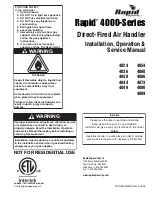
100
T-Series Climate Changer Air Handler IOM •
CLCH-SVX06A-EN
Diagnostics
This section is intended to be used as a diagnostic aid only. For detailed repair
procedures, contact your local Trane service representative.
WARNING
Hazardous Service Procedures!
The maintenance and troubleshooting procedures recommended in this section of the
manual could result in exposure to electrical, mechanical or other potential safety
hazards. Always refer to the safety warnings provided throughout this manual
concerning these procedures. When possible, disconnect all electrical power including
remote disconnect and discharge all energy storing devices such as capacitors before
servicing. Follow proper lockout/tagout procedures to ensure the equipment cannot
be inadvertently energized. When necessary to work with live electrical components,
have a qualified licensed electrician or other individual who has been trained in
handling live electrical components perform these tasks. Failure to follow all of the
recommended safety warnings provided, could result in death or serious injury.
including remote disconnects before servicing. Follow proper lockout/tagout
procedures to ensure the power can not be inadvertently energized. When necessary
to work with live electrical components, have a qualified licensed electrician or other
individual who has been trained in handling live electrical components perform these
tasks. Failure to follow all of the recommended safety warnings provided, could result
in death or serious injury.
Table 18. Air handler troubleshooting recommendations
Symptom
Probable Cause
Recommended Action
Bearing is excessively
hot
First start after relubrication (Grease
distribution)
Allow machine to cool down and restart.
Over-lubrication
Clean surface of grease and purge.
Over tensioned belts
Adjust belt tension.
No lubricant
Apply lubricant. Check bearings for damage.
Misaligned bearing
Correct alignment. Check shaft level.
Motor fails to start
Blown fuse or open circuit breaker
Replace fuse or reset circuit breaker.
Overload trip
Check and reset overload.
Improper wiring or connections
Check wiring with diagram supplied on unit.
Improper current supply
Compare actual supply power with motor
nameplate recommendations. Contact power
company for adjustments.
Mechanical failure
Check that motor and drive rotate freely. Check
bearing lubricant.
Motor stalls
Open phase
Check line for an open phase.
Overloaded motor
Reduce load or replace with larger motor.
Low line voltage
Check across AC line. Correct voltage if possible.




































